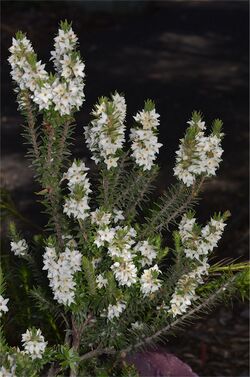Biology:Epacris decumbens
| Epacris decumbens | |
|---|---|

| |
| In the Australian National Botanic Gardens | |
| Scientific classification | |
| Kingdom: | Plantae |
| Clade: | Tracheophytes |
| Clade: | Angiosperms |
| Clade: | Eudicots |
| Clade: | Asterids |
| Order: | Ericales |
| Family: | Ericaceae |
| Genus: | Epacris |
| Species: | E. decumbens
|
| Binomial name | |
| Epacris decumbens (I.Telford) E.A.Br.[1]
| |
| Synonyms[1] | |
| |
Epacris decumbens is a species of flowering plant in the heath family Ericaceae and is endemic to a restricted area of New South Wales. It is a straggling, low-lying shrub with hairy branchlets, elliptic to egg-shaped leaves, and tube-shaped, white flowers.
Description
Epacris decumbens is a straggling, low-lying shrub that typically grows to a height of up to 80 cm (31 in) and has shaggy-hairy stems up to 1 m (3 ft 3 in) long. The leaves are elliptic to egg-shaped, 12–20 mm (0.47–0.79 in) long and 3.8–7.6 mm (0.15–0.30 in) wide on a hairy petiole 1–2 mm (0.039–0.079 in) long. The flowers are 13–17 mm (0.51–0.67 in) in diameter and arranged singly on a peduncle about 3 mm (0.12 in) long, the sepals 5.3–6.1 mm (0.21–0.24 in) long. The petal tube is 1.0–1.3 mm (0.039–0.051 in) long, the lobes 7–8 mm (0.28–0.31 in) long. Flowering occurs in November and December and the fruit is a capsule about 4 mm (0.16 in) in diameter.[2][3]
Taxonomy
This species was first formally described in 1992 by Ian R.H. Telford who gave it the name Rupicola decumbens in the journal Telopea from specimens he collected with Michael Crisp, near Glen Davis in 1976.[3][4] In 2015, Elizabeth Anne Brown changed the name to Epacris decumbens in Australian Systematic Botany.[5] The specific epithet (decumbens) means "prostrate but with the tips rising upwards", referring to the habit of the plant.[3][6]
Distribution and habitat
Epacris decumbens grows on sandstone clifs, ledges and rock crevices in the Glen Davis and Cudgegong River areas of New South Wales.[2][3]
References
- ↑ 1.0 1.1 "Epacris decumbens". Australian Plant Census. https://biodiversity.org.au/nsl/services/apc-format/display/4536441.
- ↑ 2.0 2.1 Powell, Jocelyn M.. "Epacris decumbens". Royal Botanic Garden Sydney. https://plantnet.rbgsyd.nsw.gov.au/cgi-bin/NSWfl.pl?page=nswfl&lvl=sp&name=Epacris~decumbens.
- ↑ 3.0 3.1 3.2 3.3 Telford, Ian R.H. (30 September 1992). "Budawangia and Rupicola, new and revised genera of Epacridaceae". Telopea 5 (1): 237–239. doi:10.7751/telopea19924966.
- ↑ "Rupicola decumbens". APNI. https://id.biodiversity.org.au/instance/apni/552586. Retrieved 14 May 2022.
- ↑ "Epacris decumbens". APNI. https://id.biodiversity.org.au/instance/apni/4536707. Retrieved 14 May 2022.
- ↑ Sharr, Francis Aubi; George, Alex (2019). Western Australian Plant Names and Their Meanings (3rd ed.). Kardinya, WA: Four Gables Press. p. 179. ISBN 9780958034180.
Wikidata ☰ Q15376877 entry
 |

